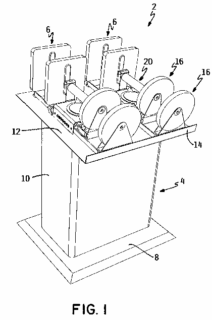In a significant decision for patent law and the fitness equipment industry, a panel of the Federal Circuit reversed a partial dismissal of PowerBlock Holdings, Inc.’s patent infringement claims brought against iFit, Inc. in the U.S. District Court for the District of Utah. The infringement allegations against iFit were based on PowerBlock’s U.S. Patent No. 7,578,771, which includes claims to a weight selection and adjustment system for a selectorized dumbbell. The opinion further clarifies the application of 35 U.S.C. § 101 to mechanical inventions and underscores the importance of claim specificity and inventive concept in patent eligibility determinations.

The Claimed Invention
PowerBlock’s patent claims to address long-standing problems (back in 2007 when the ʼ771 patent was filed) with traditional selectorized dumbbells, which require users to manually adjust mechanical selectors to change the weight. This manual process can lead to improper engagement, posing safety risks and inconvenience for the user. The system described and claimed in the ʼ771 patent automates weight selection using an electric motor that moves a selector to couple the desired number of weight plates to each end of the dumbbell handle, based on user input. The claims asserted against iFit describe a system including stacks of nested weight plates, a handle, a movable selector with multiple adjustment positions, and an electric motor operatively connected to the selector.
The District Court’s Ruling
After the complaint was filed by PowerBlock, iFit flexed with a motion to dismiss under Rule 12(b)(6) arguing that the asserted claims were invalid as patent ineligible under 35 U.S.C. § 101. The district court, applying the Supreme Court’s two-step Alice/Mayo framework for patent eligibility under § 101, found that all but one claim of the ʼ771 patent were ineligible under § 101. At step one of the Alice/Mayo framework, the court concluded that the claims were directed to the abstract idea of automated weight stacking, implemented with generic components. At step two, the court determined that the claims did not add significantly more than the abstract idea itself, thus failing the test for patent eligibility. Only one claim (claim 19), which recited means for adjusting the dumbbell weight without user contact, survived the motion to dismiss.
The Federal Circuit’s Analysis and Reversal
The Federal Circuit panel, comprised of the Hon. Richard G. Taranto and Hon. Kara F. Stoll, circuit judges, and the Hon. Mark C. Scarsi, district judge, for the United States District Court for the Central District of California, sitting by designation, disagreed with the district court’s analysis and conclusion and emphasized the need to consider the claims “in their entirety” to avoid oversimplifying the scope. The court found that claim 1, representative of the asserted claims, was not directed to an abstract idea but rather to a specific mechanical improvement in selectorized dumbbells:
1. A weight selection and adjustment system for a selectorized dumbbell, which comprises:
(a) a selectorized dumbbell, which comprises:
(i) a stack of nested left weight plates and a stack of nested right weight plates;
(ii) a handle having a left end and a right end; and
(iii) a movable selector having a plurality of different adjustment positions in which the selector may be disposed, wherein the selector is configured to couple selected numbers of left weight plates to the left end of the handle and selected numbers of right weight plates to the right end of the handle with the selected numbers of coupled weight plates differing depending upon the adjustment position in which the selector is disposed, thereby allowing a user to select for use a desired exercise weight to be provided by the selectorized dumbbell; and
(b) an electric motor that is operatively connected to the selector at least whenever a weight adjustment operation takes place, wherein the electric motor when energized from a source of electric power physically moves the selector into the adjustment position corresponding to the desired exercise weight that was selected for use by the user.
The panel explained that the claim’s limitations — including the configuration of weight plates, the handle, the movable selector, and the electric motor — provided sufficient specificity and structure to conclude that it “is not directed to an abstract idea” and to avoid preemption of all automated weight selection systems.
The panel distinguished this case from prior decisions where claims merely recited abstract results or generalized steps without concrete implementation. Here the claims required a particular arrangement of mechanical components and a defined method for automating weight adjustment, making them “‘a concrete thing, consisting of parts, or of certain devices and combination of devices…,” similar to a GPS satellite patent that the Federal Circuit upheld under § 101 over a decade ago.
The Key Takeaways
The Federal Circuit’s reversal means that the case will return to the district court for additional proceedings. This decision reinforces several important principles for patent eligibility:
- Specificity Matters – Claims that recite specific mechanical structures and their interactions are less likely to be deemed abstract.
- Avoiding Overgeneralization – Claims must be considered in their entirety, and conventional components should not be disregarded simply because they appear in the prior art.
- Mechanical Inventions Are Not Excluded – This opinion confirms that mechanical improvements, even if broad, can be patent-eligible if they provide a concrete technological solution. In other words, not all automation or mechanical improvements are abstract ideas, and well-drafted claims directed to concrete technological solutions remain protectable under U.S. patent law.